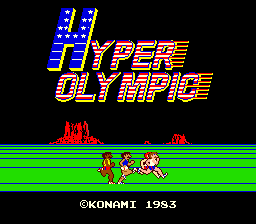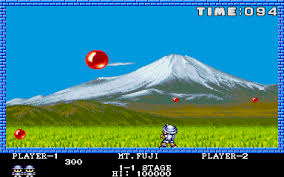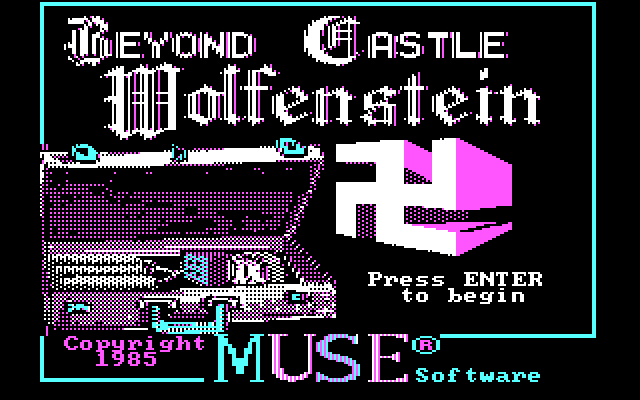Donkey Kong Junior ( Ⓒ 1982 Nintendo of America.
Something of a role reversal for this superb sequel to the seminal 1981 platform-based original, with Mario now cast as the villain (the only Mario game in which this occurre Ⓓ and Donkey Kong the captured victim.
Donkey Kong's son, DK Junior, must rescue his captured father from Mario's clutches by climbing and jumping his way over vines, chains and platforms before he can reach his father. Junior has to race against time while avoiding the horrible Snapjaws, Nitpickers, and Sparks released by Mario.
Like the original, Donkey Kong Junior features 4 different stages, but in the US version, one or both of the middle stages are omitted in the first 3 levels. In the Japanese versions, all 4 stages are played in their logical order. See Updates below for complete details.
CAST OF CHARACTERS :
Donkey Kong Junior - The baby ape in the white unitard with a big J printed on the front, this is the son of Donkey Kong and he must rescue his father from Mario's cage.
Mario - This game is quite possibly the ONLY game in Mario's long history where he is the enemy.
Donkey Kong - Poor DK was captured by Mario after the events portrayed in Donkey Kong. Now he must helplessly watch as his son comes to the rescue.
Snapjaws - These mechanical mouths must be avoided. Blue Snapjaws will drop down a vine and continue to fall off the screen, while Red Snapjaws will climb back up a vine and pose a more permanent threat.
Nitpickers - There are two types of Nitpickers in the game. Small Nitpickers appear on the Springboard Stage and occasionally drop eggs on Junior as they fly around the top branch. Large Nitpickers appear on the Chains stage and weave back and forth in an attempt to hinder Junior's chances at rescuing his father.
Sparks - These volts of electricity patrol the Mario's Hideout Stage. The red variety follows the loop that they begin on while the blue version follows the vertical strips from one level to the next as they drop to the bottom of the screen.
Fruit - Junior will find various pieces of fruit scattered throughout each stage that he will pluck when he touches them. The fruit will fall and take out any enemy in its path until it reaches the bottom of the screen. They are one of the best sources for bonus points.
Keys - On the Chains Stage, Junior must push 6 of these up a chain into the lock positioned at the top of the stage. When he does, Papa will be set free.
- TECHNICAL -
Main CPU : Z80 (@ 3.072 Mhz)
Sound CPU : I8035 (@ 400 Khz)
Sound Chips : DAC
Screen orientation : Vertical
Video resolution : 224 x 256 pixels
Screen refresh : 60.00 Hz
Palette colors : 256
Players : 2
Control : 4-way joystick
Buttons : 1 (JUMP)
- TRIVIA -
Released in August 1982.
Some versions, especially the Japanese version, have the 'Junior' abbreviated in the printed title, therefore "Donkey Kong Jr.".
The song that is played in the intro sequence before gameplay is Bach's 'Toccata and Fugue in D Minor'.
The song that is played during the 'Keep Going to Mario's Hideout - Be Careful' cut scene that preceeds the Mario's Hideout Stage is from the 'Can-Can'.
Steve Wiebe holds the official record for this game with 1,139,800 points on March 14, 2009.
A bootleg of this game is called "Junior King".
A bootleg of the Japanese version runs on the "Moon Cresta" hardware.
Donkey Kong Junior also spawned a cartoon series of the same name : Ruby-Spears Productions. Produced By Joe Ruby, Ken Spears. Originally aired September 17, 1983 as part of 'Saturday Supercade' on CBS.
- UPDATES -
The 'Extra Lives' dip switch can actually be set to 10000, 15000, 20000, or 25000; the default is 10000.
The Japanese and bootleg boards have all 4 screens displayed in their original, logical order 1-2-3-4.
For the US board, they changed it to somewhat match the original Donkey Kong's 'How high can you try/get?' theme. With the screen order as follows :
L1 : 1-4
L2 : 1-2-4
L3 : 1-3-4
L4 : 1-2-3-4
L5 onward remain the same as L4
In Versions featuring the Junior abbreviated in the title screen ('Jr.'):
1. You are allowed to enter a name up to 12 letters instead of 3.
2. Red Snapjaws regenerate after being killed by fruit starting in L5 instead of L4.
- SCORING -
Jump over one opponent : 100 points
Jump over two+ opponents : 300 points
Push key in lock : 200 points
Pick a fruit : 400 points
Hit 1st opponent with fruit : 800 points
Hit 2nd opponent with fruit : 1200 points
Hit 3rd+ opponent with fruit : 1600 points
- TIPS AND TRICKS -
• When you start the game, Junior will start at the bottom left corner of the Vines stage. Your job is to navigate him to the top so that he can progress to the next levels. Here are some strategies for each level...
• VINES STAGE : This is the first stage of each level.
1) To start out, Junior must grab the vines above him, and climb up to one of the two ledges to his right. He can jump to the next vine from either ledge, where he must fall down to the tree top below.
2) Carefully jump right from one tree top to the next before grabbing the fourth vine from the right. Climb up above the right ledge and maneuver Junior over to the far right vines. Climb up and onto the branch above. Jump over any Snapjaws that pose a threat and leap up to the higher section of the branch before leaping for the key and ending the stage.
3) Along the way, the pear and apple fruit prizes should be plucked with ease, and if you have time, it pays in the early levels to eliminate any of the red Snapjaws since they won't come back. However, from L4 onward, they will regenerate at Mario's feet. The banana is in a precarious position and should only be plucked if time and safety permits.
• SPRINGBOARD STAGE : This stage earns it's name by hosting a springboard at the bottom of the screen. Its purpose is to provide Junior with a shortcut. In the US version, this stage is omitted in L1 and L3.
1) Ordinarily, Junior must jump on the springboard to reach the tree top on the opposite side. Then he must ride the moving platform to the right and climb up the chains beneath the pulley. He must step on to a ledge which is placed directly beneath the point at which Small Nitpickers like to lay eggs, so watch out. Then he must jump to the left to reach the first hold. When the small platform is beneath him, he must drop down and let it carry him to the next hold which rises and falls.
2) If Junior uses the springboard as a shortcut, he can move directly from the start to this small ledge by pressing the jump button at precisely the moment when he hits the springboard, and he will launch up to the small platform immediately.
3) Junior can only jump up and grab the second hold when it is in its lowest position. Once he safely has it, he must reach left and grab the chains that extend below Papa. After pulling himself up, he must navigate through the gauntlet of Small Nitpickers to reach the chains on the right side, where he must climb up a little further to reach the branch. Jumping over the gap in the branch, and timing his jumps to ensure that he doesn't collide with any Small Nitpickers, he can reach the key and end the stage.
• MARIO'S HIDEOUT : In the US version, this stage is omitted in L1 and L2.
1) The layout of this electrically-filled chamber is substantially simpler than the previous stages, but it poses an even greater threat. Not only are Sparks a danger to Junior's feet on the ground, they also pose a danger when they pass overhead. A nervous player may anxiously jump over a Spark only to realize too late that another spark was headed Junior's way above him. The route is simple. From the start, cross over to the right, climb up, cross back over to the left, climb up, cross once more to the right, climb up again, and finally back to the left in an effort to reach the key.
2) While the Red Sparks remain in their loops, the Blue Sparks move from the top of the screen to the bottom, taking the blue vertical pathways along the way. In the beginning, a Blue Spark will randomly choose one of the four pathways beneath Mario, so cross below Mario with care.
3) The fruits are easily plucked on each level, but nailing Sparks with them will take extra timing, and may put you in a bad position if you're not aware of your surroundings.
• CHAINS STAGE : This is Junior's last chance to save Papa, so it's now or never.
1) Papa's cage is positioned above a set of locks, and the keys to those locks are located on chains directly below them. All Junior has to do is push those keys up and insert them into the locks and grant Papa his freedom.
2) Blocking his way will be stubborn Red Snapjaws and Large Nitpickers that Mario sends after Junior. The Large Nitpickers will fly from one end of the screen to the other before swooping down a level and reversing direction.
3) Obviously it is faster for Junior to push up keys two at a time when the chance is available, but that exposes Junior to twice the danger as Red Snapjaws could be located on either chain at any given moment. So proceed with caution, and try to save the apples for the moments when the Red Snapjaws are located beneath them and can be done away with for bonus points. But from L4 onward, beware: as in the Vines Stage, Red Snapjaws will regenerate at Mario's feet.
4) Once Junior unlocks every lock, Papa will come tumbling down and mighty Junior will catch him before the game starts all over again from the Vines stage at a more difficult level.
- SERIES -
1. Donkey Kong (1981)
2. Donkey Kong Junior (1982)
3. Donkey Kong 3 (1983)
- STAFF -
Designed & programmed by : Shigeru Miyamoto, Masao Yamamoto, Kenji Nishizawa, Masayoshi.O, H. Hoshino
Music by : Hirokazu Tanaka
Produced by : Gunpei Yokoi
- PORTS -
NOTE : In most of these ports, the printed title uses the abbreviation 'Jr.' instead of fully spelling out 'Junior'.
• Consoles :
Colecovision (1982)
Mattel Intellivision (1982)
Atari 2600 (1983)
Atari XEGS
Nintendo Famicom (1986)
Atari 7800 (1988)
Nintendo Famicom (1988, "Donkey Kong Classics") : Nintendo Famicom's 1986 offerings of both "Donkey Kong" and "Donkey Kong Jr." in one cartridge.
Nintendo Game Boy Advance (2002, "e-Reader Series")
Nintendo Wii (2006, "Virtual Console" - NES version)
• Computers :
Atari 800 (1983)
Tandy Color Computer (1983, "Junior's Revenge")
Tandy Color Computer 3 (1986, "Return of Junior's Revenge")
• Others :
LCD tabletop game (1983) released by Coleco : This is a color LCD game (color accomplished with a color plastic overlay on the LCD), and is back-lit by an external light source (room light, sun, etc.). It can't be played in the dark like the VFD games.
LCD tabletop game released by Nintendo (Game&Watch).
- SOURCES -
Game's rom.
Machine's picture.
|
(1982)-20230913-022418-75ef1021ee69eb5414f2103193d4c8dc.png)
(1982)-20230913-022427-e77dafdd78bf11f16b7d37dc77d33986.png)
(1982)-20230913-022434-6551eee9b14143cac7eb1baf35ed4739.png)
(1982)-20230913-022440-720e820b37cf48998f35ec1a88284843.png)
(1982)-20230913-022444-673420dab7678eb3a8b9d5bc4c473326.png)

(1984)-20230913-123336-68c7fca1e3bba5e49ec90847dcdd456b.png)
-20230912-142417-0a8b2799af5e9b658b8fdb0558fc99c8.png)
-20230915-132956-f6ada47e77d9937a5af80b8f4c3826cf.png)





